人教版英语八年级Unit-2写作课
- 格式:ppt
- 大小:1.23 MB
- 文档页数:13
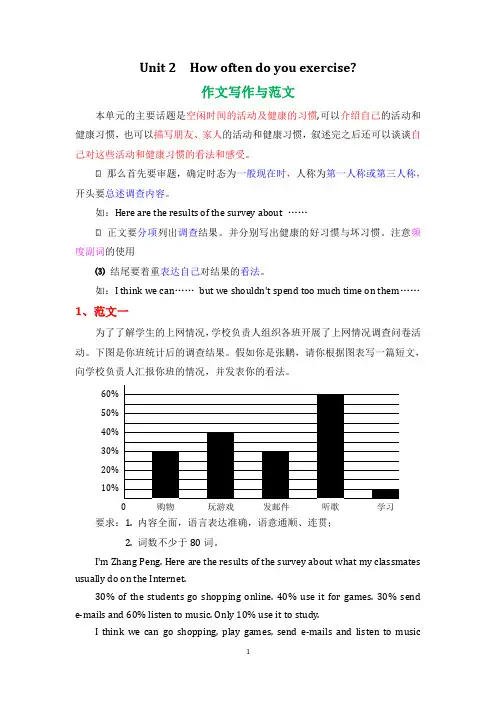
Unit 2 How often do you exercise?作文写作与范文本单元的主要话题是空闲时间的活动及健康的习惯,可以介绍自己的活动和健康习惯,也可以描写朋友、家人的活动和健康习惯,叙述完之后还可以谈谈自己对这些活动和健康习惯的看法和感受。
⑴ 那么首先要审题,确定时态为一般现在时,人称为第一人称或第三人称,开头要总述调查内容。
如:Here are the results of the survey about ……⑴ 正文要分项列出调查结果。
并分别写出健康的好习惯与坏习惯。
注意频度副词的使用⑶结尾要着重表达自己对结果的看法。
如:I think we can……but we shouldn't spend too much time on them……1、范文一为了了解学生的上网情况,学校负责人组织各班开展了上网情况调查问卷活动。
下图是你班统计后的调查结果。
假如你是张鹏,请你根据图表写一篇短文,向学校负责人汇报你班的情况,并发表你的看法。
60%50%40%30%20%10%0购物玩游戏发邮件听歌学习要求:1. 内容全面,语言表达准确,语意通顺、连贯;2. 词数不少于80词。
I'm Zhang Peng. Here are the results of the survey about what my classmates usually do on the Internet.30% of the students go shopping online. 40% use it for games. 30% send e-mails and 60% listen to music. Only 10% use it to study.I think we can go shopping, play games, send e-mails and listen to musiconline, but we shouldn't spend too much time on them. As students, we should make good use of the Internet to study. I usually learn English through online dictionaries. I get a lot from them.我叫张鹏。
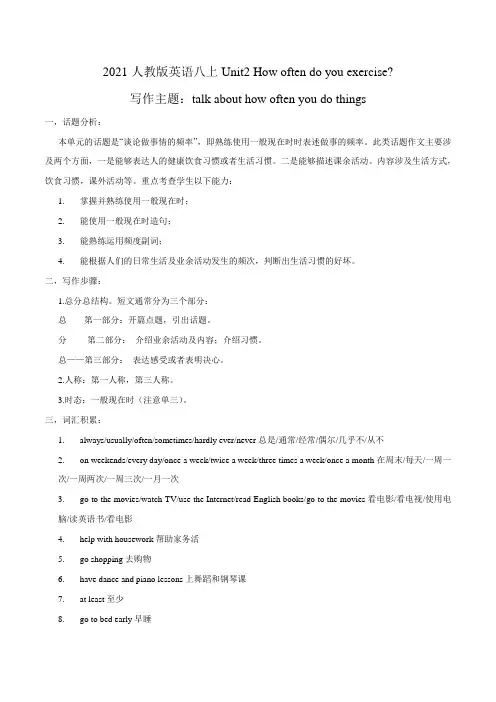
2021人教版英语八上Unit2 How often do you exercise?写作主题:talk about how often you do things一,话题分析:本单元的话题是“谈论做事情的频率”,即熟练使用一般现在时时表述做事的频率。
此类话题作文主要涉及两个方面,一是能够表达人的健康饮食习惯或者生活习惯。
二是能够描述课余活动。
内容涉及生活方式,饮食习惯,课外活动等。
重点考查学生以下能力:1.掌握并熟练使用一般现在时;2.能使用一般现在时造句;3.能熟练运用频度副词;4.能根据人们的日常生活及业余活动发生的频次,判断出生活习惯的好坏。
二,写作步骤:1.总分总结构。
短文通常分为三个部分:总------第一部分:开篇点题,引出话题。
分-------第二部分:介绍业余活动及内容;介绍习惯。
总——第三部分:表达感受或者表明决心。
2.人称:第一人称,第三人称。
3.时态:一般现在时(注意单三)。
三,词汇积累:1.always/usually/often/sometimes/hardly ever/never总是/通常/经常/偶尔/几乎不/从不2.on weekends/every day/once a week/twice a week/three times a week/once a month在周末/每天/一周一次/一周两次/一周三次/一月一次3.go to the movies/watch TV/use the Internet/read English books/go to the movies看电影/看电视/使用电脑/读英语书/看电影4.help with housework帮助家务活5.go shopping去购物6.have dance and piano lessons上舞蹈和钢琴课7.at least至少8.go to bed early早睡9.play sports做体育运动10.drink milk喝牛奶11.be good for health对健康有益12.eat fruit and vegetables吃水果和蔬菜13.not at all一点也不14.stay up late熬夜15.more than多于四,句型积累:1.I often go to the movies.我经常看电影。
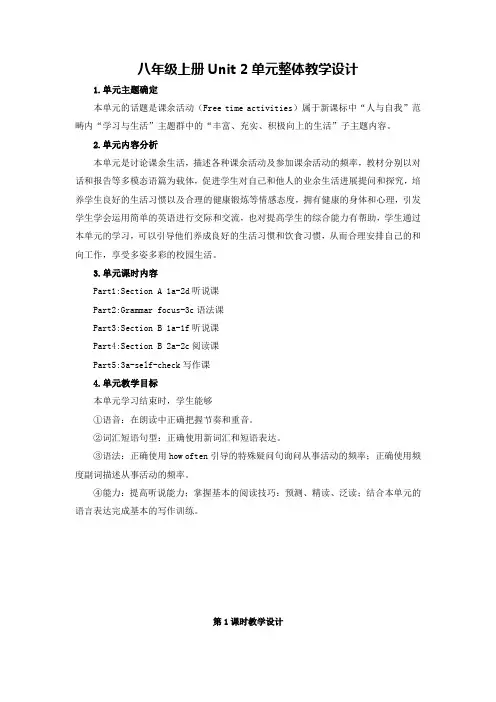
八年级上册Unit 2单元整体教学设计1.单元主题确定本单元的话题是课余活动(Free time activities)属于新课标中“人与自我”范畴内“学习与生活”主题群中的“丰富、充实、积极向上的生活”子主题内容。
2.单元内容分析本单元是讨论课余生活,描述各种课余活动及参加课余活动的频率,教材分别以对话和报告等多模态语篇为载体,促进学生对自己和他人的业余生活进展提问和探究,培养学生良好的生活习惯以及合理的健康锻炼等情感态度,拥有健康的身体和心理,引发学生学会运用简单的英语进行交际和交流,也对提高学生的综合能力有帮助,学生通过本单元的学习,可以引导他们养成良好的生活习惯和饮食习惯,从而合理安排自己的和向工作,享受多姿多彩的校园生活。
3.单元课时内容Part1:Section A 1a-2d听说课Part2:Grammar focus-3c语法课Part3:Section B 1a-1f听说课Part4:Section B 2a-2c阅读课Part5:3a-self-check写作课4.单元教学目标本单元学习结束时,学生能够①语音:在朗读中正确把握节奏和重音。
②词汇短语句型:正确使用新词汇和短语表达。
③语法:正确使用how often引导的特殊疑问句询问从事活动的频率;正确使用频度副词描述从事活动的频率。
④能力:提高听说能力;掌握基本的阅读技巧:预测、精读、泛读;结合本单元的语言表达完成基本的写作训练。
第1课时教学设计一、教学内容:Section A 1a-2d二、课型:听说课三、语篇研读What(主要内容):谈论课余简单的生活为主要话题,以对各类频度副词的学习和掌握,List(1a)看图列举周末活动;Listening(1b、2a、2b)主要是程涛正在讨论多久做这些活动,通过程涛的描述学习和理解频率的使用;Practice(1c、2c编对话关于周末有什么课余活动以及活动频率;Role-play(2d)Jack和Claire的对话,讨论下一周有哪些课余活动以及这些活动发生的频率,Claire丰富的课余生活。
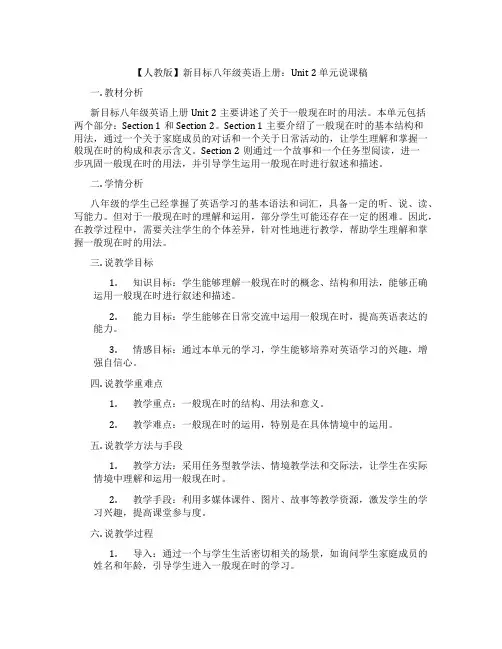
【人教版】新目标八年级英语上册:Unit 2 单元说课稿一. 教材分析新目标八年级英语上册Unit 2主要讲述了关于一般现在时的用法。
本单元包括两个部分:Section 1和Section 2。
Section 1主要介绍了一般现在时的基本结构和用法,通过一个关于家庭成员的对话和一个关于日常活动的,让学生理解和掌握一般现在时的构成和表示含义。
Section 2则通过一个故事和一个任务型阅读,进一步巩固一般现在时的用法,并引导学生运用一般现在时进行叙述和描述。
二. 学情分析八年级的学生已经掌握了英语学习的基本语法和词汇,具备一定的听、说、读、写能力。
但对于一般现在时的理解和运用,部分学生可能还存在一定的困难。
因此,在教学过程中,需要关注学生的个体差异,针对性地进行教学,帮助学生理解和掌握一般现在时的用法。
三. 说教学目标1.知识目标:学生能够理解一般现在时的概念、结构和用法,能够正确运用一般现在时进行叙述和描述。
2.能力目标:学生能够在日常交流中运用一般现在时,提高英语表达的能力。
3.情感目标:通过本单元的学习,学生能够培养对英语学习的兴趣,增强自信心。
四. 说教学重难点1.教学重点:一般现在时的结构、用法和意义。
2.教学难点:一般现在时的运用,特别是在具体情境中的运用。
五. 说教学方法与手段1.教学方法:采用任务型教学法、情境教学法和交际法,让学生在实际情境中理解和运用一般现在时。
2.教学手段:利用多媒体课件、图片、故事等教学资源,激发学生的学习兴趣,提高课堂参与度。
六. 说教学过程1.导入:通过一个与学生生活密切相关的场景,如询问学生家庭成员的姓名和年龄,引导学生进入一般现在时的学习。
2.新课呈现:通过一个关于家庭成员的对话和一个关于日常活动的,展示一般现在时的结构和用法。
3.实践环节:学生分组进行角色扮演,运用一般现在时进行对话,巩固所学知识。
4.任务型阅读:学生阅读一个关于故事的文章,回答相关问题,进一步理解一般现在时的用法。
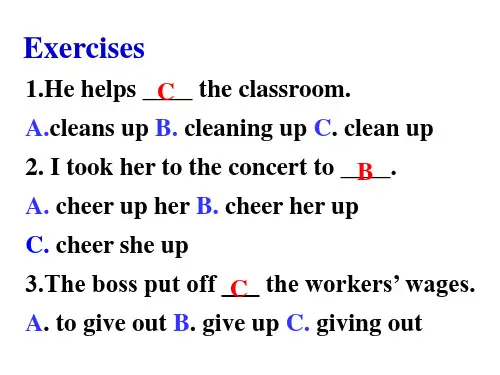
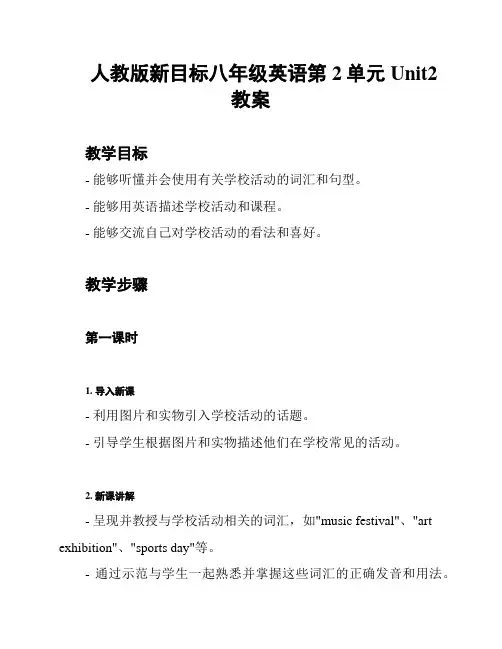
人教版新目标八年级英语第2单元Unit2教案教学目标- 能够听懂并会使用有关学校活动的词汇和句型。
- 能够用英语描述学校活动和课程。
- 能够交流自己对学校活动的看法和喜好。
教学步骤第一课时1. 导入新课- 利用图片和实物引入学校活动的话题。
- 引导学生根据图片和实物描述他们在学校常见的活动。
2. 新课讲解- 呈现并教授与学校活动相关的词汇,如"music festival"、"art exhibition"、"sports day"等。
- 通过示范与学生一起熟悉并掌握这些词汇的正确发音和用法。
- 操练这些词汇,并与学生一起编制句子来描述学校活动。
3. 听力训练- 播放关于学校活动的对话,要求学生仔细听并选择正确的图片。
- 学生互相对话,讨论听到的对话内容。
4. 对话练- 分组或两人一组,让学生模仿对话,表演关于学校活动的场景。
- 鼓励学生用英语进行自由对话,并互相分享自己参与过的学校活动。
5. 作业布置- 课堂分发作业卷,要求学生写一篇短文,介绍自己最喜欢的学校活动,并陈述原因。
第二课时1. 短文分享- 学生轮流与同桌分享自己写的短文。
- 鼓励其他学生提出问题或表达对短文的意见和建议。
2. 阅读训练- 学生阅读一篇关于学校活动的短文,并回答相关问题。
- 教师引导学生理解短文的内容,帮助他们解决阅读中遇到的问题。
3. 语法讲解- 教授句子结构"What do you think of + 学校活动?"和相应的答语。
- 帮助学生理解并掌握这种句子结构的用法。
4. 语法练- 学生分组或两人一组,互相提问"What do you think of + 学校活动?"并回答对方。
- 引导学生用所学词汇和句型互相交流和讨论自己对学校活动的看法和喜好。
5. 总结课堂内容- 教师带领学生回顾本节课所学的词汇、句型和语法。
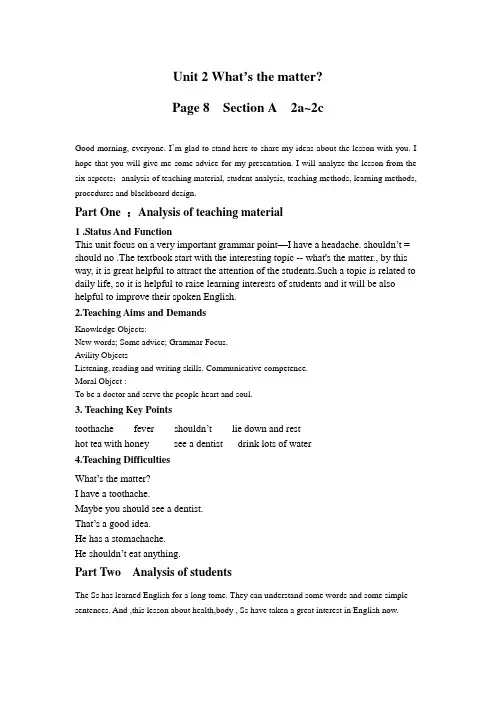
Unit 2 What’s the matter?Page 8 Section A 2a~2cGood morning, everyone. I’m glad to stand here to share my ideas about the lesson with you. I hope that you will give me some advice for my presentation. I will analyze the lesson from the six aspects:analysis of teaching material, student analysis, teaching methods, learning methods, procedures and blackboard design.Part One :Analysis of teaching material1 .Status And FunctionThis unit focus on a very important grammar point—I have a headache. should n’t = should no .The textbook start with the interesting topic -- what's the matter., by this way, it is great helpful to attract the attention of the students.Such a topic is related to daily life, so it is helpful to raise learning interests of students and it will be also helpful to improve their spoken English.2.Teaching Aims and DemandsKnowledge Objects:New words; Some advice; Grammar Focus.Avility ObjectsListening, reading and writing skills. Communicative competence.Moral Object :To be a doctor and serve the people heart and soul.3. Teaching Key Pointstoothache fever shouldn’t lie down and resthot tea with honey see a dentist drink lots of water4.Teaching DifficultiesWhat’s the matter?I have a toothache.Maybe you should see a dentist.That’s a good idea.He has a stomachache.He shouldn’t eat anything.Part Two Analysis of studentsThe Ss has learned English for a long tome. They can understand some words and some simple sentences. And ,this lesson about health,body , Ss have taken a great interest in English now.Part Three Teaching aids and methodsTeaching Aids :A tape recorder; A projector.Teaching Methods:Listening,reading and writing methods. Pairwork.Part Four Learning methods1. Teach Ss how to be successful language learners.2. Teach Ss how to develop the reading skill — skim & scan; how to communicate with others; how to learn new words; how to learn independently;3. Get the Ss to form good learning habits.Part Five Teaching ProceduresStep I Greet the class .Show the new words on the screen.Read the new words to students and ask them to repeat.Talk about the Chinese meanings.fever lie rest honey dentist water shouldn’tStep II2aNow open your books at Page 8. First read the eight items to students and ask them to repeat.toothache sore throat stomachache fever lie down and rest hot tea with honey see a dentist drink lots of waterListen to the recording . Please pay attention to the first one has been done for you . The boy has a toothache and the advice is to see dentist.Then check the answers on the blackboard.Step III2bFirst look at the four pictures. Each picture illustrates one of the conversation.Now we’ll listen to the conversations again. This time listen for the missing words. Write the missing words on the blank lines.(Play the recording one time only)Then check the answers.Step IV2c PairworkFirst I’ll have two students read the dialogue in the box .A: What’s the matter?B: I have a toothache.A: Maybe you should see a dentist.B: That’s good idea.Now practice the conversation in Activity 2b. Take turns having the problems and giving advice.Ask students to work in pairs. After they practice a while, have several pairs of student present their conversations to the class.Step V Grammar Focus(Show on the screen)I have a headache.He has a toothache.You should go to bed.He shouldn’t eat anything.She should see a dentist.shouldn’t = should notStep VI SummaryThis class we’ve learnt some advice to people who have health problems. Who wants to be a doctor in future?OK.Serve the people heart and soul.Step VII Homework:Practice the conversations and review the Grammar Focus.Part Six Blackboard designUnit 2 What’s the matter?toothache lie down and restsore throat hot tea with honeystomachache see a dentistfever drink lots of water。
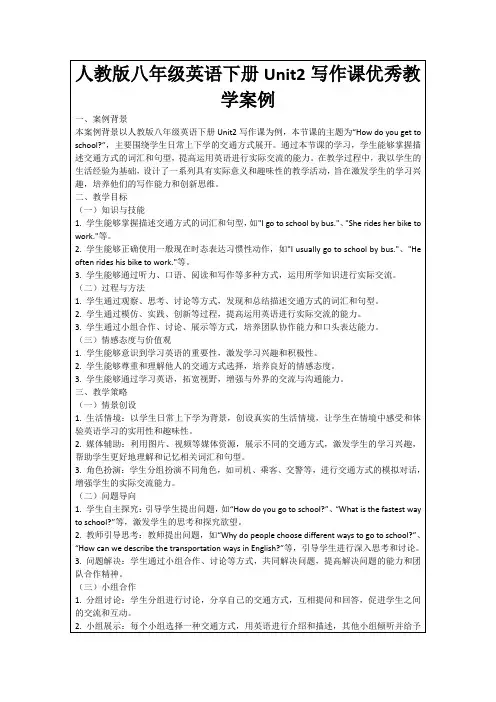
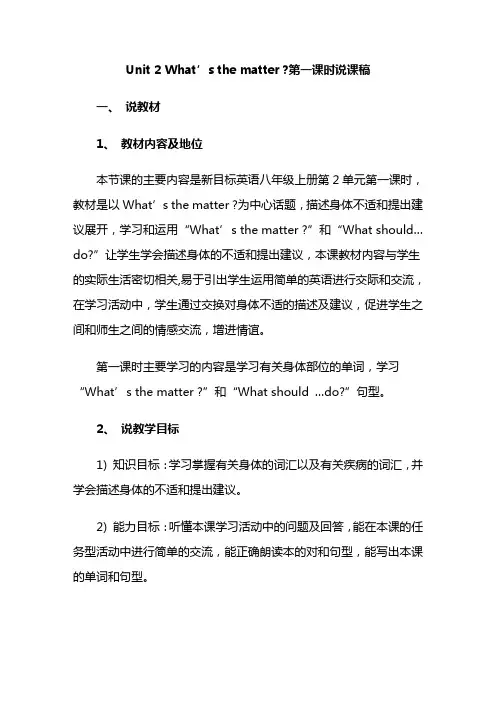
Unit 2 What’s the matter ?第一课时说课稿一、说教材1、教材内容及地位本节课的主要内容是新目标英语八年级上册第2单元第一课时,教材是以What’s the matter ?为中心话题,描述身体不适和提出建议展开,学习和运用“What’s the matter ?”和“What should…do?”让学生学会描述身体的不适和提出建议,本课教材内容与学生的实际生活密切相关,易于引出学生运用简单的英语进行交际和交流,在学习活动中,学生通过交换对身体不适的描述及建议,促进学生之间和师生之间的情感交流,增进情谊。
第一课时主要学习的内容是学习有关身体部位的单词,学习“What’s the matter ?”和“What should …do?”句型。
2、说教学目标1) 知识目标:学习掌握有关身体的词汇以及有关疾病的词汇,并学会描述身体的不适和提出建议。
2) 能力目标:听懂本课学习活动中的问题及回答,能在本课的任务型活动中进行简单的交流,能正确朗读本的对和句型,能写出本课的单词和句型。
3) 情感目标:通过描述自己的身体的不适提出建议,表达自己的看法,使学生在人际交往中学会关心别人,增进情谊。
4) 文化意识目标:用恰当的方式表达自己的看法,增进人际交往中学会关心别人的能力,了解英美国家询问和表达身体不适的习惯,培养世界意识。
3、说教学重难点重点:本节课主要学习身体部位的单词和一些疾病的词汇,以及身体不适的表达及建议。
难点:身体不适的表达及建议二、说学情初二年级的学生对英语已经有了一定的基础,但本地区部分学生对学习英语的兴趣不是很浓,在学习中,他们更喜欢从游戏中或活动中学习,这样更能提高他们的学习兴趣,让他们更轻松地掌握英语知识。
三、说教法作为教学的引导着,我遵循新课程“学生是学习的主人,一切的教学活动设计在以学生为本”的教学理念,坚持“为学生的发展,必须培养学生的自主性、能动性、独立性和创造性”的教学原则。

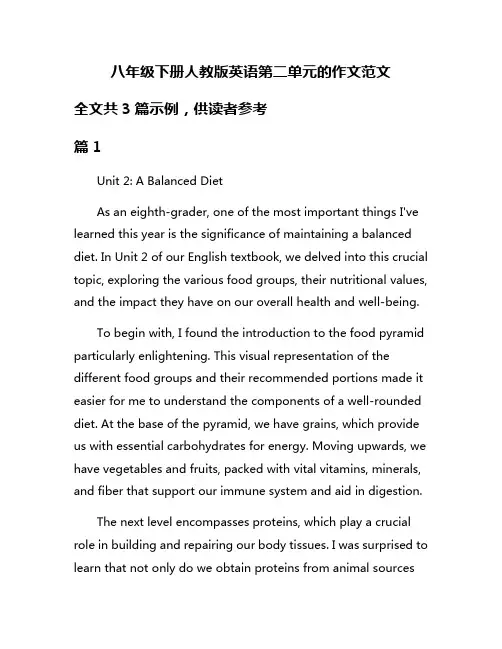
八年级下册人教版英语第二单元的作文范文全文共3篇示例,供读者参考篇1Unit 2: A Balanced DietAs an eighth-grader, one of the most important things I've learned this year is the significance of maintaining a balanced diet. In Unit 2 of our English textbook, we delved into this crucial topic, exploring the various food groups, their nutritional values, and the impact they have on our overall health and well-being.To begin with, I found the introduction to the food pyramid particularly enlightening. This visual representation of the different food groups and their recommended portions made it easier for me to understand the components of a well-rounded diet. At the base of the pyramid, we have grains, which provide us with essential carbohydrates for energy. Moving upwards, we have vegetables and fruits, packed with vital vitamins, minerals, and fiber that support our immune system and aid in digestion.The next level encompasses proteins, which play a crucial role in building and repairing our body tissues. I was surprised to learn that not only do we obtain proteins from animal sourceslike meat, fish, and eggs, but also from plant-based sources such as legumes, nuts, and seeds. This knowledge has encouraged me to incorporate more plant-based proteins into my diet, contributing to a healthier and more sustainable lifestyle.Moving on, the dairy group caught my attention, as it provides us with calcium, which is essential for strong bones and teeth. I've always enjoyed drinking milk and eating yogurt, but now I have a deeper appreciation for their nutritional value.Lastly, we have the oils and fats group, which, when consumed in moderation, can provide us with essential fatty acids and energy. However, I've learned that it's crucial to choose healthier options like olive oil, avocados, and nuts over saturated and trans fats found in processed foods.One of the most valuable lessons I've gained from this unit is the importance of portion control. Even healthy foods, when consumed in excess, can lead to weight gain and other health issues. The food pyramid serves as a guide, helping me to maintain a balanced intake of different food groups in appropriate quantities.In addition to the food pyramid, we explored the concept of a balanced diet through engaging exercises and real-life examples. We learned about the impact of different nutrients onour bodies and how deficiencies or excesses can lead to various health problems. For instance, a lack of iron can cause anemia, while excessive sugar consumption can increase the risk of diabetes and obesity.Furthermore, the unit emphasized the significance of reading nutrition labels on packaged foods. By understanding the ingredients and nutritional information, we can make informed decisions about the foods we consume. This knowledge has empowered me to be more mindful of my food choices, particularly when it comes to processed and fast foods, which are often high in unhealthy fats, sodium, and added sugars.One of the most memorable activities in this unit was creating our own balanced meal plans. We had to consider the different food groups, portion sizes, and nutritional values to design a day's worth of meals that met our individual dietary needs. This hands-on exercise not only reinforced our understanding of a balanced diet but also encouraged us to take an active role in planning our meals and making healthier choices.Beyond the classroom, this unit has had a profound impact on my daily life. I've become more conscious of the foods Iconsume, and I've made efforts to incorporate a wider variety of fruits, vegetables, and whole grains into my diet. I've also learned to read nutrition labels more carefully and to limit my intake of processed and sugary foods.Moreover, I've started to appreciate the importance of hydration and have made a conscious effort to drink more water throughout the day. Staying hydrated not only benefits our physical health but also our cognitive function, which is crucial for academic performance.In conclusion, Unit 2 of our English textbook has been an invaluable learning experience for me. It has provided me with a solid foundation for understanding the principles of a balanced diet and its impact on our overall well-being. Armed with this knowledge, I feel empowered to make healthier choices and to cultivate lifelong habits that will contribute to a balanced and fulfilling life.As I continue my academic journey, I will carry with me the lessons learned from this unit, applying them not only to my personal health but also to my studies and future endeavors. A balanced diet is not just about the foods we consume; it's about nourishing our bodies, minds, and spirits, enabling us to thrive and reach our full potential.篇2Title: Embracing Cultural Diversity: A Journey of UnderstandingAs an eighth-grader, I have come to realize that the world is a vibrant tapestry of cultures, each one unique and fascinating in its own way. Through my studies, particularly in the second unit of our English textbook, I have embarked on a captivating journey of exploring cultural diversity, and it has broadened my horizons in ways I never imagined.One of the most striking realizations I've had is that culture is not just about the language we speak or the traditional attire we wear; it runs much deeper than that. Culture encompasses a vast array of elements, from beliefs and values to customs and traditions, shaping the way we perceive and interact with the world around us.I vividly remember the excitement I felt when we delved into the topic of festivals and celebrations. Each culture has its own unique way of marking significant occasions, be it religious, seasonal, or historical. The vibrant colors, the intricate rituals, and the sense of community that these celebrations foster left me in awe. From the dazzling displays of fireworks during Chinese NewYear to the joyous festivities of Diwali in India, I found myself enthralled by the rich tapestry of cultural expressions.Furthermore, our studies opened my eyes to the diverse culinary traditions that exist across the globe. I was fascinated to learn about the intricate flavors and ingredients that are cherished in different cultures. The aromatic spices of Indian curries, the delicate preparation of sushi in Japan, and the hearty stews of African cuisine – each dish told a story, carrying with it the history and values of the people who crafted it.Beyond the tangible aspects of culture, I also gained a deeper appreciation for the intangible elements, such as values, beliefs, and worldviews. I learned that different cultures approach concepts like family, respect, and spirituality in unique ways, and these differences shape the very essence of their societies. It was a humbling experience to realize that my own cultural lens was just one among many, and that embracing diversity means opening our minds and hearts to perspectives that may initially seem foreign to us.One of the most profound lessons I took away from this unit was the importance of cultural sensitivity and respect. As global citizens, it is crucial that we approach different cultures with an open mind and a willingness to learn. We must be mindful of ouractions and words, ensuring that we do not inadvertently offend or diminish the significance of another culture's practices or beliefs.Moreover, I realized that cultural diversity is not just something to be studied in textbooks; it is a living, breathing reality that surrounds us every day. In our increasingly interconnected world, we are constantly exposed to individuals from diverse backgrounds, and it is our responsibility to foster an environment of mutual understanding and appreciation.As I navigate through my teenage years and beyond, I am determined to continue embracing cultural diversity with open arms. I will strive to learn about the customs and traditions of others, to ask questions with genuine curiosity, and to challenge my own preconceptions and biases. By doing so, I believe I can contribute to a more harmonious and inclusive society, where people of all backgrounds can coexist and thrive.In conclusion, my journey through the second unit of our English textbook has been a transformative experience. It has opened my eyes to the rich tapestry of cultures that exist in our world, and has instilled in me a profound appreciation for the beauty and complexity of human diversity. As I continue to grow and learn, I will carry these lessons with me, using them as acompass to guide my interactions with others and to foster a deeper understanding of the world around me.篇3Unit 2: A Stitch in Time Saves NineOne autumn afternoon after classes, I was sitting by the window in my room, staring blankly outside as the wind gently rustled the leaves on the trees. My mind kept drifting back to the English homework - we had been asked to write a composition on the proverb "A stitch in time saves nine." I sighed deeply, feeling completely stumped about how to approach this topic.Just then, my grandma walked in with a basket filled with colorful yarns and knitting needles. She always enjoyed knitting during her free time. As she settled into the armchair next to me, carefully untangling a skein of soft yellow yarn, an idea struck me.I would ask Grandma about the meaning behind that old proverb!"Grandma," I began hesitantly. "Do you know what the saying 'A stitch in time saves nine' means?"She looked up from her knitting, a warm smile crinkling the corners of her eyes. "Why, of course, my dear. It simply meansthat if you fix a small problem right away, you'll prevent it from becoming a much bigger issue later on."Nodding slowly, I felt the gears in my mind beginning to turn. Grandma's patient explanation had sparked a realization within me about the deeper significance of those words."You see," Grandma continued, "when you're knitting or sewing and you notice a tiny hole or mistake in your work, it's best to stop immediately and correct it with just one small stitch. Because if you leave it be and keep going, that tiny flaw will gradually unravel and grow larger until you end up with a messy, unsightly tangle that's incredibly difficult to fix."As an example, she showed me the soft cream-colored shawl draped over the back of her chair. Running my fingers along the delicate stitches, I could feel the evenness and quality of her handiwork. Not a single mistake or dropped stitch marred its beauty."I always make sure to check my knitting regularly and correct any tiny errors right away," Grandma said. "That way, my finished pieces turn out neat and perfect, just as I intended. Otherwise, all my hard work could unravel into a jumbled mess if I'm not diligent about maintaining it from the start."Her words painted such a vivid picture in my mind that I immediately understood the proverb's message. Just like knitting, so many areas of our lives require consistent effort and prompt attention to small problems before they have a chance to spiral out of control.I thought about my own experiences - how procrastinating on assignments led to rushed, sloppy work; how neglecting to study regularly made it extremely difficult to catch up before major tests; how leaving my bedroom messy inevitably transformed it into a disastrous pigsty that took hours to clean properly. In each case, addressing issues right away through diligent, consistent actions could have prevented bigger headaches down the road.As I watched Grandma's skilled hands deftly loop the yarn, creating intricate patterns with each careful stitch, I felt inspired to apply that same level of mindfulness and preventative care to all aspects of my own life - my studies, chores, commitments and responsibilities. By staying on top of things with regular small efforts, I could maintain order and stability, avoiding the overwhelming chaos that comes from accumulating neglect.My grateful thanks went out to Grandma, whose simple knitting hobby had inadvertently taught me one of life's mostvaluable lessons. From that day onwards, the proverb "A stitch in time saves nine" became my personal mantra - a powerful reminder to tackle problems head-on while they're still small and manageable. After all, a few diligent stitches today can prevent the need for drastically more effort to untangle the knotted consequences tomorrow.With fresh motivation, I picked up my pen and began composing my English essay, allowing the words to flow from the newfound wisdom and understanding I had gained. Little did I know that Grandma's knitting metaphor would become instrumental not just in writing that composition, but in guiding。
人教版八年级下学期英语第二单元作文课件English: In the second unit of the eighth grade English textbook of the People's Education Edition, we have learned about different festivals and traditions around the world. It has been a fascinating journey exploring how different cultures celebrate and commemorate various occasions. From the vibrant colors of Holi in India to the solemn processions of Semana Santa in Spain, each festival reveals a unique insight into the beliefs and values of the people who celebrate it. Through our studies, we have also gained a deeper understanding of the significance of these festivals in fostering cultural identity and promoting unity among communities. By learning about the customs and practices of different cultures, we have not only broadened our knowledge but also developed a greater appreciation for the rich diversity that exists in our world.中文翻译: 在人教版八年级英语教材下册的第二单元中,我们学习了世界各地不同的节日和传统。